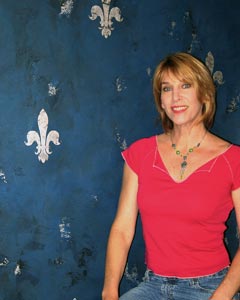
Royal Design Studio,
National City, Calif.
by John Strieder
in all kinds of ways. For Melanie Royals, it started with a casual book purchase at the Boston Museum of Art.
The time was the early 1980s and she was in her early 20s, taking art classes and studying fashion design. The book she bought, “The Art of Stenciling,” stimulated her interest in the old-school art of using stencils to paint borders on walls and ceilings.
Her first stencil was a border she did in her son’s room. Her second project was for pay, though not much: She stenciled five rooms in a bed-and-breakfast a friend was developing in a Victorian home.
For decorative painters, the early 1980s might as well have been the Dark Ages. The trick with stenciling was finding out how to do it at all. “You kind of were on your own as far as discovering techniques,” Royals says.
Only a few companies made stencil designs, she says. And every design was, as she puts it, “ducks, geese and hearts,” primitive New England styles that had little in common with the styles favored in San Diego, where she lived.
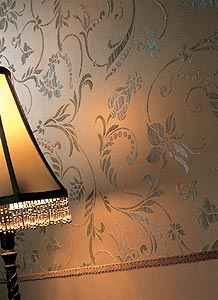 So Royals started cutting and designing her own stencils. And the rest is history. So Royals started cutting and designing her own stencils. And the rest is history.
Today, Royals is a minor celebrity, described on the Web site of a friend and faux painter as a “rockstar of the stenciling world.” She’s made many appearances on television discussing her work. People ask to have photos taken with her at trade shows.
She founded Royal Design Studio in San Diego in 1991, and the company released its first catalog of precut designer stencils in 1994. The company offered Royals’ designs exclusively at first, but it has recently begun featuring historic patterns and collections of other artists as well.
Royal Design sells stencils, stencil supplies and paint and faux supplies. It also offers books, DVDs and other instructional materials that give customers fresh ideas about what they can achieve with those supplies. The Royal Design Studio Web site, puts the designs and techniques of Royals and other artists on display for the online world to see. “We have an area of the Web site called ‘Applied Artistry’ where we feature the work of our students and customers,” Royals says. “It’s very inspiring for people to see how others have applied and interpreted our designs. It offers many ideas and encouragement.”
Royals is president and creative director of the company today, all without having earned a degree. “I have no formal training in art or business,” she says. “It’s all been trial and error.”
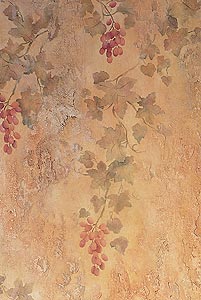 As she became more accomplished, Royals began adding her own innovations to the stencil techniques she had learned. She used detailed shading to make stencil designs look hand-painted. Instead of just methodically moving a stencil from one spot to the next to create a repetitive border, she laid one stencil design on top of another. As she became more accomplished, Royals began adding her own innovations to the stencil techniques she had learned. She used detailed shading to make stencil designs look hand-painted. Instead of just methodically moving a stencil from one spot to the next to create a repetitive border, she laid one stencil design on top of another.
Royal Designs’ 1994 catalog introduced “free-form stenciling,” a concept based on Royals’ idea of layering stenciled patterns in a nonrepetitive, free-form manner to create a custom look and fit.
The studio’s most popular finish is “A Taste of Tuscany,” which combines glazing, free-form stenciling and troweled texture for an “Italian villa” look. The finish incorporates the company’s Grape Clusters and Grape Ivy Vine stencils, which users mix, match and configure to taste. A Royal Design instructional video, “Stenciling With Textures,” describes the steps for creating the look. “Each time it’s done it’s unique,” Royals says. “It’s not repetitive, as opposed to a border. It adds to that hand-painted look.”
Royals combined stenciling with other decorative finishes and custom treatments, too, allowing for even more unique designs. Her experimentation paved the way for Royal Design to introduce an instructional program in 2002 called “Extraordinary Stenciled Effects.” The program includes six instructional videos and a home tour video, plus a manual and “recipe cards” for 30 different finishes. “A lot of painters are good technicians,” she says. “They’re really good at applying finishes. But both professional decorative painters and their customers need to be inspired.”
To give just one example of an interesting effect, the studio’s popular “fabric damask” design can be combined with glazes to create aging and discoloring effects that simulate fading wallpaper. “Although a stencil is a very mechanical tool, you can combine techniques and products to make it look unique,” Royals says.
In 2003, Royals introduced the decorative painting industry to another fresh concept, the art of decorative masking, by founding a second company, Modello Designs.
A “Modello” is a disposable stencil-like tool that is cut from thin vinyl and backed with a removable adhesive. “It’s kind of the same idea as a stencil,” she says. “It’s a tool to control the application of pattern or paint on a surface. But because of its adhesive quality and the way that it is transferred to the surface, it’s a one-time use pattern.”
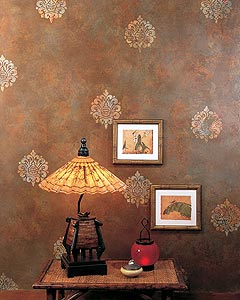 The one-time-use concept met with resistance from customers at first. But the company markets Modellos as a complementary option to stencils, and it is enjoying a lot of repeat business, Royals says. The one-time-use concept met with resistance from customers at first. But the company markets Modellos as a complementary option to stencils, and it is enjoying a lot of repeat business, Royals says.
Modello Designs intended to offer only custom-sized patterns cut to order. But the company is currently designing stock, standard-sized “Modello Pronto!” designs to sell alongside the custom patterns. It has developed 24 “Master Methods” decorative techniques, described in step-by-step illustrated instructions and a materials list, to go with the new designs. “These standardized patterns can provide an easy and inexpensive introduction to Modellos,” Royals says.
Modellos have several advantages over stencils. They can be cut much larger than stencils, so their designs can be without breaks. They can be applied to an entire surface before painting starts, unlike stencils, which must be moved along as a job progresses.
And a Modello pattern can be used in reverse — the “negative space” can be removed instead of the design part of the pattern.
Today’s painters are more open to possibilities than they used to be, Royals says. “Both decorative painters and the customers who contract them have become more sophisticated over the years. The ducks and hearts are long gone. It’s really become a more elevated art form.”
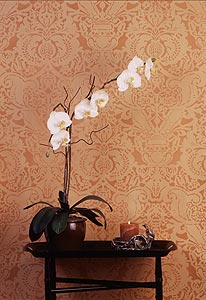 Royals was one of the first members of Stencil Artisans League Inc. (SALI) in 1984. She has served on the SALI board of directors in a variety of capacities and was the founding president of the San Diego chapter. She delivered the keynote speech at SALI’s 2005 convention in Baltimore. Royals was one of the first members of Stencil Artisans League Inc. (SALI) in 1984. She has served on the SALI board of directors in a variety of capacities and was the founding president of the San Diego chapter. She delivered the keynote speech at SALI’s 2005 convention in Baltimore.
She is also an accomplished author, having sold more than 30,000 copies of her book “Trompe L’oeil Murals Using Stencils.” Her latest, “Painted Illusions: Creating Trompe L’oeil Effects with Stencils,” was released in September 2004, and a third book on decorative finishing is in the works.
Royals’ aim as a craftswoman is simple. Instead of duplicating what is already out there, she creates something different. She helps push and pull the art of decorative painting and finishing along, she says. “I try to be true to my art, true to myself. That’s really my motivation. It’s just a passion for creating.”
|

